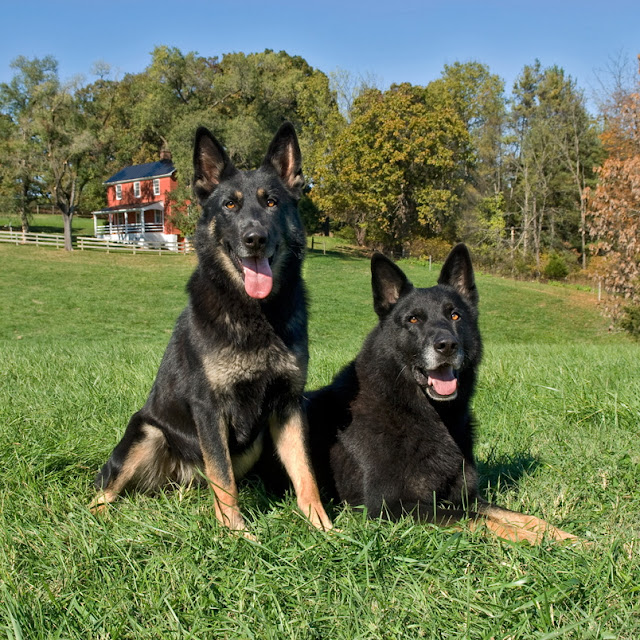
This is a placeholder text
Group text
by BlackthornGSD on 27 January 2012 - 21:01
The picture you posted looks more of a very dark black/tan, I wouldn't call her bi-color though she could be. The markings obove her eyes and on the chest plus the quantity of black on her legs and arms do not suggest she's a true bi-color. The dog in your avatar looks to me is a true bi-color and a very beautiful one.
Well... she is bicolor. :) She's a half-sister to the dog in my avatar, through the same dam. She's definitely a bicolor, complete with tarheels and toemarks and no tan behind the ears or on the back of her neck and no tan on her belly/chest.
Here's more photos of her: https://picasaweb.google.com/100619446956993754435/BlackthornSHunter
You can kind of see the toemarks in this picture:

And the tarheels in this one:

This is her son out of Bandit v Wolfsheim (sable with black recessive)---he got the black recessive from his dad:


There are other examples, just harder to know details about dogs I don't own.
Here is a dog who I bet is also bicolor without the black recessive: http://www.pedigreedatabase.com/german_shepherd_dog/dog.html?id=627039
This female is a bicolor (blowing coat in the picture), who never produced black, even when bred to a black dog: http://www.pedigreedatabase.com/german_shepherd_dog/dog.html?id=462237
Christine
by joanro on 27 January 2012 - 21:01
by Ibrahim on 27 January 2012 - 21:01
You are the best one to know what color she really is and I take your word for it, but still she does not look like the typical bicolors I am used to, she even does not look like her half sister in the avatar, however her offspring especially the one in the last picture, the penciling leaves no doubt he's a true bi-color. Thank you for the additional pics and links.
I add: The two links you provided I doubt they're bi-color, though they never produced solid blacks or passed solid black genes they look to me dark b/t, they could have a recessive bi-color gene but they look more b/t to me and not true bi-colors, I could be wrong but no bi-color would have this much of markings on the cheeks. Wouldn't it be possible that your bitch also is b/t with bicolor recessive ?!!!!
Ibrahim
by BlackthornGSD on 27 January 2012 - 22:01

She also produced bicolors--with and without the black recessive. I think Hunter (Nike x Alex) is bicolor/bicolor (bicolor from both parents) and Coal (Nike x Ashen) is bicolor/black (bicolor from mom and black from dad):

(Of course, if tan point (bicolor) and saddle are the same gene and it's all modifiers that make the difference, it gets a lot more complicated.)
Of the dogs I linked earlier, when Queen was bred to a solid black male, her puppies were bicolors. That makes sense if she were bicolor/bicolor. If she were black/tan-bicolor they look like Nike -- like a blanket back. I don't know that I could tell the difference between a dog that is blacktan/bicolor and one that is blacktan/black.
black-tan/bicolor (Nike)

blanket-back black-tan/black (Jubilee) (black gene from her dad, black-tan from her mom):

Coal (bicolor/black):

feel free to email me at giblaut @ gmail.com if you want,
Christine
by Ibrahim on 27 January 2012 - 22:01
Ibrahim
by pod on 28 January 2012 - 08:01
"I don't think it's one bit clear. There's plenty of bicolors with recessive black and poor pigment, and plenty of showline dogs with no recessive black and great pigment. Or should I say, "multitudes". I don't think it's clear that recessive black has ANY influence on pigment. [except in it's homozygous state, in order to CONCEAL pigment]"
Daryl, there multiple threads on here discussing this. Dark sables, commonly known as black sables in the GSD, tend to carry recessive black. Now this doesn't mean that all dark sables will carry it, just that the presence of the rec black allele has an influence in pigment. Also, not all dogs that carry it will be darker than average. Likewise B&Ts. Not all are the same in intensity but information from experienced breeders on this forum does tell us that the presence of recessive black is likely to contribute.
The reason for the variation in pigment intensity is the influence of modifying genes. All homozygous sables aw aw are not the same. Likewise all heterzygotes aw at, or all aw a, or B&Ts at at or at a. We see a pattern of continuous variation influenced by the A locus alleles themselves, with modifier contribution.
by darylehret on 28 January 2012 - 09:01
Now this doesn't mean that all dark sables will carry it, just that the presence of the rec black allele has an influence in pigment. Also, not all dogs that carry it will be darker than average.
That disclaimer doesn't make anything "clearly evident" to me, just an opinion supported by subjective perception.
There's two types of pigment (melanin).
Eumelanin - dark brown and black pigment
Pheomelanin - red and yellow (blonde) pigment

Gain-of-function Agouti alleles and loss-of-function Mc1r alleles each cause a pheomelanic phenotype, loss-of-function Agouti alleles and gain-of-function Mc1r alleles each cause a eumelanic phenotype, and animals carrying combinations of Agouti and Mc1r alleles with potentially opposite effects exhibit a coat color phenotype predicted by Mc1r rather than the Agouti genotype; in other words, Mc1r is epistatic to Agouti.
~Mammalian Genome, Volume 15, 798–808 (2004)
by pod on 28 January 2012 - 13:01
by pod on 29 January 2012 - 08:01
by darylehret on 29 January 2012 - 15:01
Contact information Disclaimer Privacy Statement Copyright Information Terms of Service Cookie policy ↑ Back to top




